5 Comfy and Cozy Winter Carriers for Babywearing
Babywearing in the colder, winter months is a great way to stay hands-free and warm - and still get all the baby snuggles. If I had a time machine, I'd go back to 2007 and tell my first-time mom-self about babywearing. I'm sad to report I didn't discover babywearing as a real solution until my third was born. Third! She is now 3 and has made it clear our babywearing days with her are numbered -- which is sad because there are some clever, comfy and innovative solutions for winter babywearing that will help you and your little one stay warm, dry and active.
To help you make your decision easier on what to wear and how to layer on cold hikes, a few of our Hike it Baby families shared what they love about their cold-weather babywearing carriers, jackets and covers.
These are just a few options, but no matter what you choose to wear, always remember to dress safe. Consider proper footwear for the hiking conditions of the day, as well as layers that can be removed as you warm up. Also keep in mind the solutions that allow you and baby to be as close as possible and allow you to share body heat.
Now, get out there and babywear this winter season! Do it for Past Me and my juggling of strollers and babies and wagons.
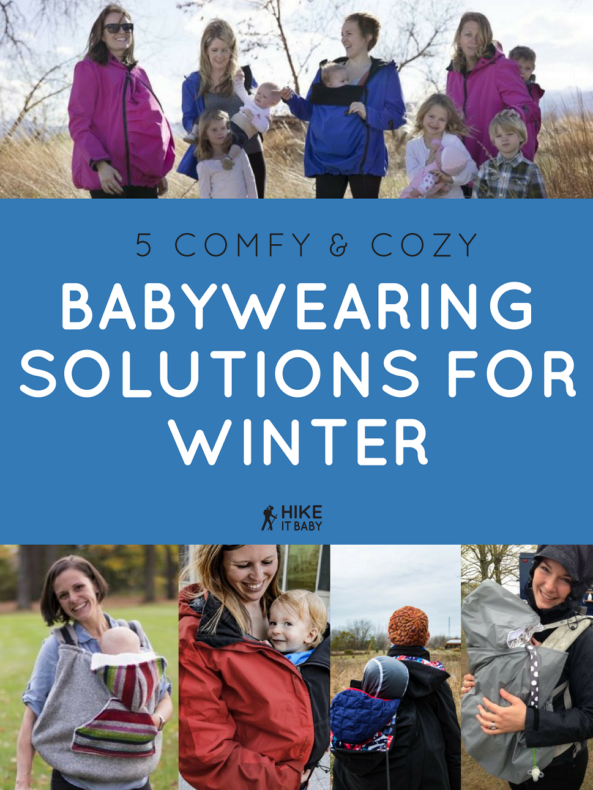
One Little Giggle
Wanna support our very own community? Fellow Hike it Baby member Kim has an Etsy shop, One Little Giggle, that offers great gear such as a fleece hoodie and rain cover. I won't lie – the pocket on the front of the fleece winter carrier cover makes me consider getting one -- just in case our independent baby changes her mind and wants to be carried. Also check out the rain cover. The body is made of a layer of ripstop material for rain protection, and the hood is lined with minky fleece.Winter Carrier Cover
I love our winter carrier cover made by Kim at One Little Giggle. The cover comes in both toddler and infant sizes and fits over any carrier. It keeps our son nice and snugly on cold days and allows us to transfer him directly to the crib or car seat when asleep, since we don’t have to bundle him up with tons of additional layers. One of my favorite features is the pocket on the front because I can stick my hands in it on cold days or use it to hold my phone. I also love the soft hood that can be removed or put up to help keep my son’s head and neck warm. Our winter carrier cover gives us the freedom to continue to enjoy the outdoors even once the weather gets cold. –Natalie Kendrach
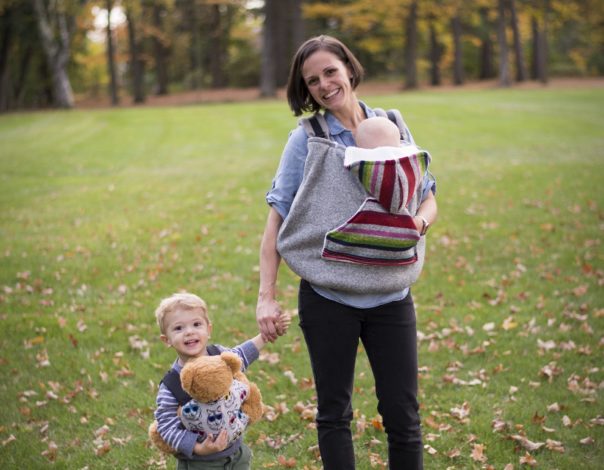 Photo credit: Caitlin Lucy Photography
Photo credit: Caitlin Lucy Photography
Rain Carrier Cover
Since we love our winter carrier cover so much, we decided to try the rain cover made by Kim at One Little Giggle. The rain cover makes it easy for us to get outside even on really rainy days. It keeps my son nice and dry without overheating either one of us. It can go over any type of carrier, comes in both infant and toddler sizes, and can even be used over the winter carrier cover for those days that are cold AND rainy. We especially love the fleece-lined hood and how small the cover folds up when not in use. Our rain carrier cover lives in our car so that we are never caught without it. –Natalie Kendrach
 Photo credit: Natalie Kendrach
Photo credit: Natalie Kendrach
Zip Us In
Looking for a babywearing solution that integrates more with your own wardrobe? Try these jacket panels (and other accessories) from Zip Us In. This is a great way to extend a jacket whether during pregnancy or while babywearing. You can add the accessories you need like a fleece liner for colder climates or a waterproof hood for the wetter areas. Visit their website or follow them on Facebook to learn more about what they offer.These things are amazing because they already fit over an existing jacket. Most standard jackets work so you only have to buy the panel. I am a hard to fit body so when i find a jacket that fits me i don't want to let it go and now with this i don't have to use any other jackets. The hood attachment is nice also, it allows for the baby to still stay protected and warm. I also have much easier access to baby so if they need to eat there is nothing between us! Overall I am super impressed and happy with Zip Us In. -Laura Castro
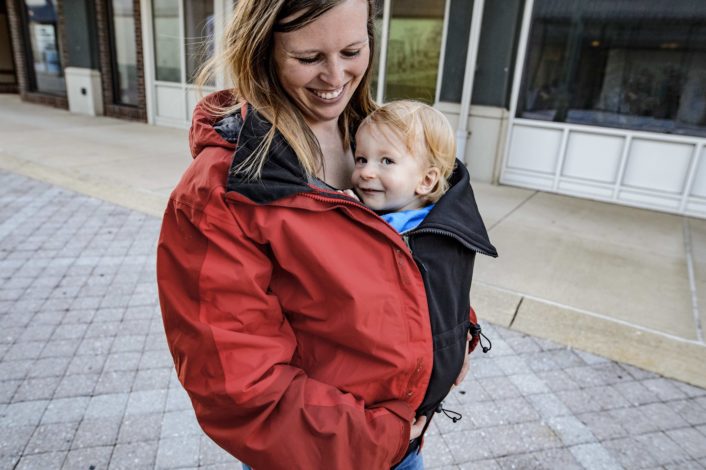 Photo credit: Laura Castro
Photo credit: Laura Castro
Karvd Glider
Detail-oriented is the best way to describe the Glider 4 babywearing jacket from Karvd. With minimal fuss and streamlined style, it's also completely appropriate for post-baby carrying. It should be noted that this is a soft-shell jacket. It's great for spring and fall and those with lighter winters. You can tell that the design team really thought about the active lifestyle; the jacket comes complete with drawstring pulls around the hood and waist. The two pockets on the jacket are large enough for keys, phone and a small wallet.I was able to seamlessly go from the grocery store run to the trail. I love the cute patterned matching adult and baby hood. Both are completely removable and the baby hood comes with long ties so that you can pull it up even while back carrying. It’s a great option for parents with younger infants to toddlers who will stay up during the whole hike. –Heidi Schertz
Photo credit: Heidi Schertz
Wanderling
This jacket does everything. It's a 4-in-1 jacket that accommodates for every stage. It has a removable panel that can be worn in front during pregnancy or as a carrier cover when carrying your kiddo in front, as well as in the back for a back carry. A plus is that it can also be completely removed and worn as an everyday jacket. As a bonus, the panel can be used as a changing pad, so that means less gear to pack! You can read Jessica's review for more details on Wanderling.I really loved utilizing this coat for regular trips around the neighborhood and out on hikes. I would suggest this coat to anyone who is pregnant and would like to carry their child in fall, winter, and spring. It’s extremely versatile and I used it to take my daughter to her sitter and then walk home. I could easily roll the panel into the carrier when not in use. This would be an excellent coat to use for anyone who wants to try backpacking with little kids since it’s pretty lightweight as well. –Jessica Featherstone
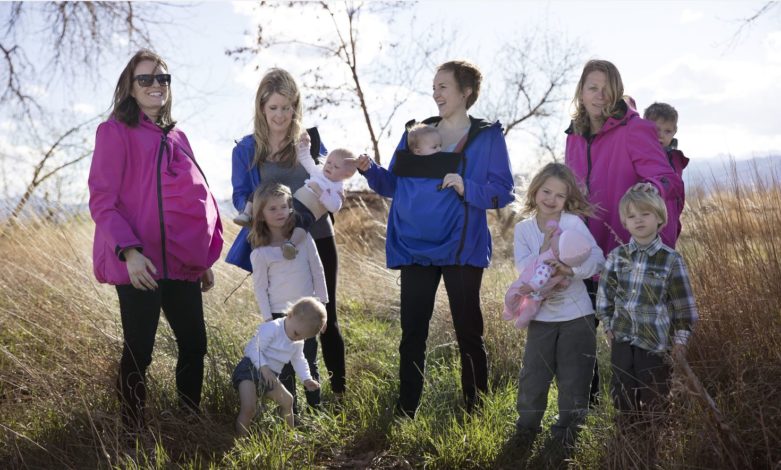 Photo courtesy of Wanderling
Photo courtesy of Wanderling
These are just a few options, but no matter what you choose to wear, always remember to dress safe. Consider proper footwear for the hiking conditions of the day, as well as layers that can be removed as you warm up. Also keep in mind the solutions that allow you and baby to be as close as possible and allow you to share body heat.
Now, get out there and babywear this winter season! Do it for Past Me and my juggling of strollers and babies and wagons.

Read more:
Related Content


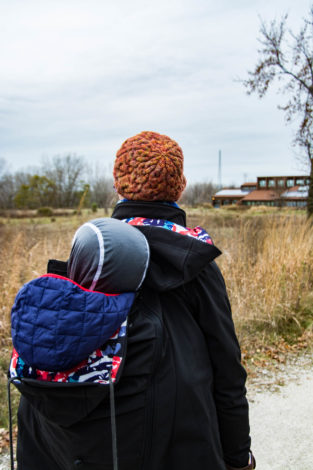


Comments